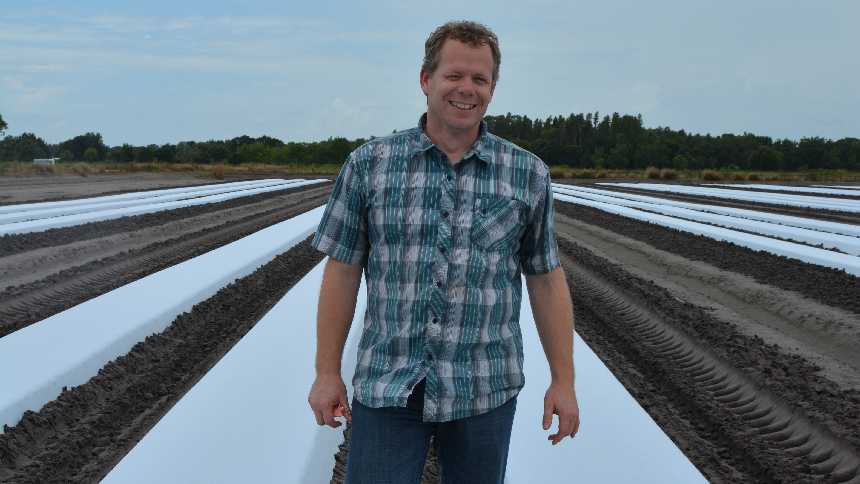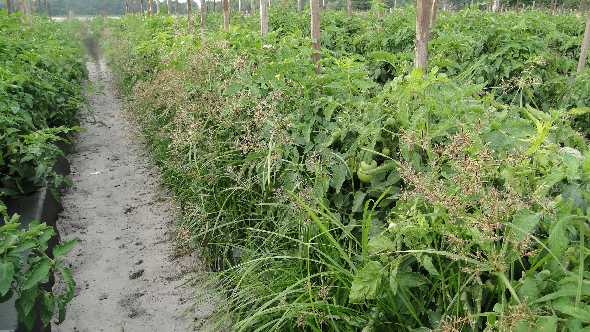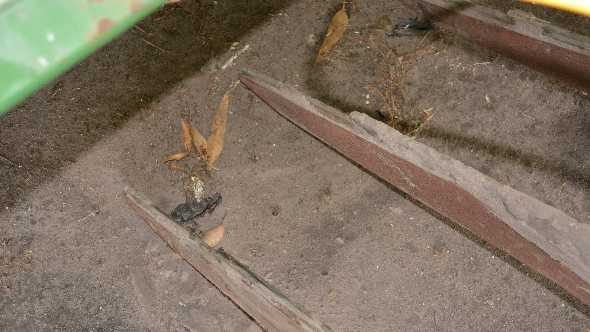Growers, Researchers Doubling Down On Weeds

Nathan Boyd has been working with growers to improve weed control tactics in the absence of methyl bromide.
Photo by Frank Giles
Weeds were the proverbial canary in the coal mine indicating that growers might face some adversity in pest management after methyl bromide was phased out. In particularly, nutsedge began popping through the plastic on beds and set growers and researchers out on a journey to find better methods to control weed pests.
“Purple and yellow nutsedge are by far the most problematic because they can puncture the plastic,” says Nathan Boyd, a weed scientist with UF/IFAS. “They are a problem for a few reasons. They can affect the stability of the plastic, which could make it more difficult to put in a second crop. And, of course, they can reduce crop yields.”
In the areas of Florida where many of the vegetable crops are grown, purple nutsedge is the most common of the two. Unfortunately, purple nutsedge also is the most difficult to control.
Boyd says beyond nutsedge, other weed problems can depend on where you are located in the state. Goosegrass and crowfoot grass are common in many vegetable fields. Nightshade species, pigweed, and purslane are the big broadleaf challenges.
“But, nutsedge is really the one that crosses all crops,” Boyd says.
Weed Shifts
Boyd says there have not been any major weed shifts in recent years, but he has observed some minor shifts in weed pressure. The best example of this is ragweed parthenium.
“It is not a new weed to the state, but historically we didn’t see it showing up in fields,” he says. “Now, we are seeing it crop up in tomato and strawberry fields.”
Green kyllinga is another sedge that is not new to the state, but has become problematic in fields where it historically was not.
“As we move further away from methyl bromide, some of these weeds that were always controlled by the fumigant have become a much larger problem,” Boyd says.
The Methyl Bromide Effect
Boyd says it’s not that methyl bromide got rid of all the weeds in a field, but it did control a wider range of species in a wider range of conditions than the available alternatives. This is partly due to the fumigant’s movement through the bed.
“Generally speaking, the fumigants we have today are more sensitive to conditions and have a more narrow spectrum of control,” he says. “One may give you decent control of nutsedge, but it is not going to control grasses and broadleaves. The difference with methyl bromide is you just used methyl bromide. Today, there are no fumigants that you can use without a herbicide. That’s the big change and it has added costs.”
♦ Boost Fumigant Coverage In Vegetable Beds ♦
Chemical Controls
One of the biggest changes since methyl bromide went away is the requirement that most growers are putting down a herbicide under the plastic. While it varies by crop, the most common combination is Dual (metolachlor, Syngenta) and Devrinol (napropamide). In strawberries, it is commonly Goal, (oxyflurofen, Dow AgroSciences) and Devrinol or Chateau (flumioxazin, Valent).
“The most common application method is you go through and fumigate your beds, then as you press your beds a second time, you have nozzles on the rig applying the herbicide,” Boyd says. “That way you are running pieces already in use in the field — not adding additional equipment. While there are some growers who run a separate herbicide rig or other set-ups, it all depends if they run the press a second time.”
Reflex (fomesafen, Syngenta) is a product that has been around a long time, but is newer to horticultural crops. Growers fighting nutsedge have been applying it under plastic for control. Boyd says the product has good tolerance with a variety of crops, so they are working to get some label expansions.
“We are doing a lot of research on Reflex applications and how to maximize performance and consistency with the product,” he says. “If I apply it in a greenhouse, I get 100% nutsedge control every time, but sometimes in the field it is much lower. So, we are working to figure out how conditions and the applications impact performance.”
Sandea (halosulfuron-methyl, Gowan Co.) can be applied over-the-top on tomatoes for nutsedge control. League (imazosulfuron, Valent) can be applied post-transplant on peppers. For eggplant and strawberries, growers have no posttransplant options nor are there any products labeled for under the plastic.
“For those guys with nutsedge problems, all they have is fumigation and the fallow period,” Boyd says. “If they don’t kill them then, they won’t.”
As for fumigants, Boyd says the alternatives will kill the nutsedge tubers that are sprouting, but if they are dormant, the efficacy is more spotty. In addition, the products must come in contact with the tubers.
“One of the big selling points for the fumigant Paladin (dimethyl disulfide, Arkema) is it works well on nutsedge,” he says.
Cultural Workings
Outside of chemicals, cultural practices have become increasingly important to keep weeds in check. That would include hand weeding, but as Boyd points out, nobody wants to do it because it is too expensive. So, what else can be done?

Purple nutsedge can overwhelm plasticulture crops if an integrated pest management program is not followed.
Photo by Frank Giles
“What has become really clear is a good fallow program has a huge impact on weeds as far as what you have during your next crop,” Boyd says. “A good program basically includes something like glyphosate and cultivation. You want to kill the weeds that are there (with glyphosate) and then stimulate another flush (with cultivation) followed by another glyphosate application to deplete the weed seed base before the next crop.”
He recommends applying the glyphosate when weeds have reached their peak germination, but before they flower or go to seed. That typically occurs when weeds are in the 3-to 4-inches range.
Cover crops also can play an important role in weed control, especially for broadleaf weeds.
“If you plant a high enough density of cover crop, it can significantly reduce your weed populations,” Boyd says. “As a general rule, it will not reduce your nutsedge problem, but it will hold it level.”
However, he cautions in a field that has significant nutsedge problems, a cover crop might not be the best option. In that case, the fallow glyphosate and cultivation combo is probably the better fit.
Boyd encourages growers not to forget the role of plastic in weed control. The plastic significantly reduces the area in fields where weeds can come through. Nutsedge is the only weed that can poke through the plastic.
“That only leaves the transplant hole and row middles and we have some good herbicide options for that (row middles),” he says. “Not that weeds can’t still be a huge problem, but it does give some perspective that plastic can be an important tool.”
In addition, totally impermeable film (TIF) can provide weed control benefits. It holds fumigants in the bed better and improves nutsedge control.
“With TIF, you can actually get an 80% reduction of nutsedge popping through the plastic,” Boyd says. “There is something about the TIF structure that inhibits nutsedge penetrating.”
Boosting Fumigant Coverage In Vegetable Beds
Nathan Boyd, a weed scientist with UF/IFAS, is currently researching ways to improve the coverage of available fumigants in the bed. He says most methyl bromide alternatives will work better with improved distribution.

Photo by Frank Giles
“We are learning some of the problems we have seen is not so much with the alternative fumigants, but how we are applying them,” he says. “So, we have been developing alternative shanks to get better distribution in the bed.”
The shank Boyd is working with has the traditional fumigant tube at 8 inches in depth, but also it has a more shallow tube to spread out the fumigation application in the bed.
“We are putting out the same amount of fumigant, but we are spreading it out inside the bed,” Boyd says. “With this approach, growers can use their same fumigation rig and just change out their shanks, which is a minimal expense.”
Boyd says this research is still in the proof-of-concept stage, but results and improved weed control look very promising. When the research is completed, EPA will need to be engaged for label approval of such application methods.










